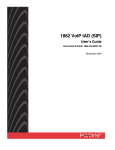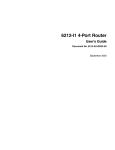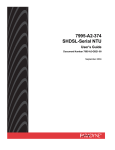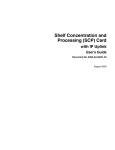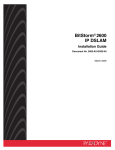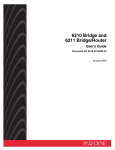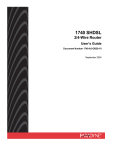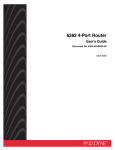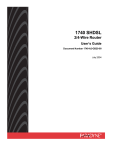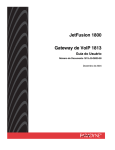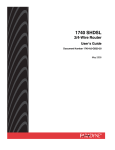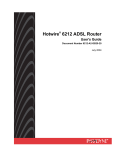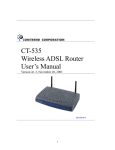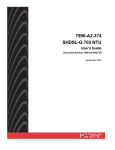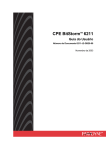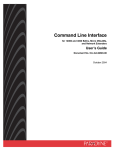Download 1862 VoIP IAD (MGCP) User's Guide
Transcript
1862 VoIP IAD (MGCP) User’s Guide Document Number 1862-A2-GB20-00 November 2004 1862 VoIP IAD User’s Guide Copyright © 2004 Paradyne Corporation. All rights reserved. Printed in U.S.A. Notice This publication is protected by federal copyright law. No part of this publication may be copied or distributed, transmitted, transcribed, stored in a retrieval system, or translated into any human or computer language in any form or by any means, electronic, mechanical, magnetic, manual or otherwise, or disclosed to third parties without the express written permission of Paradyne Corporation, 8545 126th Ave. N., Largo, FL 33773. Paradyne Corporation makes no representation or warranties with respect to the contents hereof and specifically disclaims any implied warranties of merchantability or fitness for a particular purpose. Further, Paradyne Corporation reserves the right to revise this publication and to make changes from time to time in the contents hereof without obligation of Paradyne Corporation to notify any person of such revision or changes. Changes and enhancements to the product and to the information herein will be documented and issued as a new release to this manual. Warranty, Sales, Service, and Training Information Contact your local sales representative, service representative, or distributor directly for any help needed. For additional information concerning warranty, sales, service, repair, installation, documentation, training, distributor locations, or Paradyne worldwide office locations, use one of the following methods: Internet: Visit the Paradyne World Wide Web site at www.paradyne.com. (Be sure to register your warranty at www.paradyne.com/warranty.) Telephone: Call our automated system to receive current information by fax or to speak with a company representative. Within the U.S.A., call 1-800-870-2221 Outside the U.S.A., call 1-727-530-2340 Document Feedback We welcome your comments and suggestions about this document. Please mail them to Technical Publications, Paradyne Corporation, 8545 126th Ave. N., Largo, FL 33773, or send e-mail to [email protected]. Include the number and title of this document in your correspondence. Please include your name and phone number if you are willing to provide additional clarification. Trademarks Acculink, Bitstorm, Comsphere, DSL the Easy Way, ETC, Etherloop, FrameSaver, GranDSLAM, GrandVIEW, Hotwire, the Hotwire logo, Jetstream, MVL, NextEDGE, Net to Net Technologies, OpenLane, Paradyne, the Paradyne logo, Paradyne Credit Corp., the Paradyne Credit Corp. logo, Performance Wizard, StormPort, TruePut are registered trademarks of Paradyne Corporation. ADSL/R, Connect to Success, Hotwire Connected, iMarc, JetFusion, JetVision, MicroBurst, PacketSurfer, Quick Channel, ReachDSL, Reverse Gateway, Spectrum Manager, and StormTracker are trademarks of Paradyne Corporation. All other products and services mentioned herein are the trademarks, service marks, registered trademarks, or registered service marks of their respective owners. CE Marking When the product is marked with the CE mark on the equipment label, a supporting Declaration of Conformity may be downloaded from the Paradyne World Wide Web site at www.paradyne.com. Select Library → Technical Manuals → CE Declarations of Conformity. 2 1862 VoIP IAD User’s Guide Preface This manual is written for Web management. It is designed to provide information to network administrators. It covers the installation, operation and applications of the VoIP IAD (Integrated Access Device). Important Safety Instructions 1. Read and follow all warning notices and instructions marked on the product or included in the manual. 2. Slots and openings in the cabinet are provided for ventilation. To ensure reliable operation of the product and to protect it from overheating, these slots and openings must not be blocked or covered. 3. Do not allow anything to rest on the power cord and do not locate the product where persons will walk on the power cord. 4. Do not attempt to service this product yourself, as opening or removing covers may expose you to dangerous high voltage points or other risks. Refer all servicing to qualified service personnel. 5. General purpose cables are used with this product for connection to the network. Special cables, which may be required by the regulatory inspection authority for the installation site, are the responsibility of the customer. Use a UL Listed, CSA certified, minimum No. 24 AWG line cord for connection to the Digital Subscriber Line (DSL) network. 6. When installed in the final configuration, the product must comply with the applicable Safety Standards and regulatory requirements of the country in which it is installed. If necessary, consult with the appropriate regulatory agencies and inspection authorities to ensure compliance. 7. A rare phenomenon can create a voltage potential between the earth grounds of two or more buildings. If products installed in separate buildings are interconnected, the voltage potential may cause a hazardous condition. Consult a qualified electrical consultant to determine whether or not this phenomenon exists and, if necessary, implement corrective action prior to interconnecting the products. 8. Input power to this product must be provided by one of the following: (1) a UL Listed/CSA certified power source with a Class 2 or Limited Power Source (LPS) output for use in North America, or (2) a certified transformer, with a Safety Extra Low Voltage (SELV) output having a maximum of 240 VA available, for use in the country of installation. 9. In addition, since the equipment is to be used with telecommunications circuits, take the following precautions: — Never install telephone wiring during a lightning storm. 3 1862 VoIP IAD User’s Guide — Never install telephone jacks in wet locations unless the jack is specifically designed for wet locations. — Never touch uninsulated telephone wires or terminals unless the telephone line has been disconnected at the network interface. — Use caution when installing or modifying telephone lines. — Avoid using a telephone (other than a cordless type) during an electrical storm. There may be a remote risk of electric shock from lightning. — Do not use the telephone to report a gas leak in the vicinity of the leak. CE Marking When the product is marked with the CE mark on the equipment label, a supporting Declaration of Conformity may be downloaded from the Paradyne World Wide Web site at www.paradyne.com. Select Support -> Technical Manuals -> Declarations of Conformity. FCC Part 15 Declaration An FCC Declaration of Conformity may be downloaded from the Paradyne World Wide Web site at www.paradyne.com. Select Support -> Technical Manuals -> Declarations of Conformity. This device complies with Part 15 of the FCC Rules. Operation is subject to the following two conditions: (1) this device may not cause harmful interference, and (2) this device must accept any interference received, including interference that may cause undesired operation. The authority to operate this equipment is conditioned by the requirement that no modifications will be made to the equipment unless the changes or modifications are expressly approved by the responsible party. This equipment has been tested and found to comply with the limits for a Class B digital device, pursuant to Part 15 of the FCC Rules. These limits are designed to provide reasonable protection against harmful interference in a residential installation. This equipment generates, uses, and can radiate radio frequency energy and, if not installed and used in accordance with the instructions, may cause harmful interference to radio communications. However, there is no guarantee that interference will not occur in a particular installation. If this equipment does cause harmful interference to radio or television reception, which can be determined by turning the equipment off and on, the user is encouraged to try to correct the interference by one or more of the following measures: • Reorient or relocate the receiving antenna. • Increase the separation between the equipment and receiver. • Connect the equipment into an outlet on a circuit different from that to which the receiver is connected. 4 1862 VoIP IAD User’s Guide • Consult the dealer or an experienced radio/TV technician for help. Notice to Users of the United States Telephone Network The following notice applies to versions of the modem that have been FCC Part 68 approved. This equipment complies with Part 68 of the FCC rules and the requirements adopted by the Administrative Council for Terminal Attachment (ACTA). On the bottom side of this equipment is a label that contains, among other information, a product identifier in the format US:AAAEQ##TXXXX. If requested, this number must be provided to the Telephone Company. This equipment is intended to connect to the Public Switched Telephone Network through a Universal Service Order Code (USOC) type RJ11C jack. A plug and jack used to connect this equipment to the premises wiring and telephone network must comply with the applicable FCC Part 68 rules and requirements adopted by the ACTA. A compliant telephone cord and modular plug is provided with this product. It has been designed to be connected to a compatible modular jack that is also compliant. The Ringer Equivalence Number (or REN) is used to determine the number of devices that may be connected to a telephone line. Excessive RENs on a telephone line may result in the devices not ringing in response to an incoming call. In most but not all areas, the sum of RENs should not exceed five (5.0). To be certain of the number of devices that may be connected to a line, as determined by the total RENs, contact the local Telephone Company. The REN for this product is part of the product identifier that has the format US:AAAEQ##TXXXX. The digits represented by ## are the REN without a decimal point. For example, 03 represents a REN of 0.3. If the modem causes harm to the telephone network, the Telephone Company will notify you in advance that temporary discontinuance of service may be required. But if advance notice is not practical, the Telephone Company will notify the customer as soon as possible. Also, you will be advised of your right to file a complaint with the FCC if you believe it is necessary. The Telephone Company may make changes in its facilities, equipment, operations or procedures that could affect the operation of the equipment. If this happens, the Telephone Company will provide advance notice in order for you to make necessary modifications to maintain uninterrupted service. If trouble is experienced with the modem, refer to the repair and warranty information in this document. If the equipment is causing harm to the telephone network, the Telephone Company may request that you disconnect the equipment until the problem is resolved. The user may make no repairs to the equipment. Connection to party line service is subject to state tariffs. Contact the state public utility commission, public service commission or corporation commission for information. If the site has specially wired alarm equipment connected to the telephone line, ensure the installation of the modem does not disable the alarm equipment. If you have questions about what will disable alarm equipment, consult your Telephone Company or a qualified installer. 5 1862 VoIP IAD User’s Guide Notice to Users of the Canadian Telephone Network NOTICE: This equipment meets the applicable Industry Canada Terminal Equipment Technical Specifications. This is confirmed by the registration number. The abbreviation IC before the registration number signifies that registration was performed based on a Declaration of Conformity indicating that Industry Canada technical specifications were met. It does not imply that Industry Canada approved the equipment. NOTICE: The Ringer Equivalence Number (REN) for this terminal equipment is labeled on the equipment. The REN assigned to each terminal equipment provides an indication of the maximum number of terminals allowed to be connected to a telephone interface. The termination on an interface may consist of any combination of devices subject only to the requirement that the sum of the Ringer Equivalence Numbers of all the devices does not exceed five. If your equipment is in need of repair, contact your local sales representative, service representative, or distributor directly. CANADA – EMI NOTICE: This Class B digital apparatus meets all requirements of the Canadian interference-causing equipment regulations. Cet appareil numérique de la classe B respecte toutes les exigences du règlement sur le matérial brouilleur du Canada. 6 1862 VoIP IAD User’s Guide Table of Contents CHAPTER 1 INTRODUCTION...........................................................................................................................9 1.1 1.2 1.3 CHAPTER 2 PRODUCT OVERVIEW .........................................................................................................................9 FEATURES ........................................................................................................................................10 FRONT PANEL LED INDICATORS ......................................................................................................11 HARDWARE INSTALLATION ..................................................................................................13 2.1 2.2 2.3 2.4 CHAPTER 3 HARDWARE INSTALLATION...............................................................................................................13 INSTALLING THE USB DRIVER .........................................................................................................14 UNINSTALLING THE USB DRIVER ....................................................................................................16 FXO ................................................................................................................................................18 LOGGING IN TO THE WEB INTERFACE..............................................................................19 3.1 3.2 CHAPTER 4 IP ADDRESS .....................................................................................................................................19 LOGIN PROCEDURE ..........................................................................................................................20 MGCP .. .........................................................................................................................................22 4.1 CHAPTER 5 MGCP CONFIGURATION ..................................................................................................................22 BASIC CONFIGURATION .........................................................................................................25 5.1 5.2 5.3 5.4 5.5 5.6 5.7 CHAPTER 6 ACCESS CONTROL ...........................................................................................................................25 WAN SETUP ....................................................................................................................................28 LAN IP ADDRESS ............................................................................................................................35 ROUTING..........................................................................................................................................36 SAVE ................................................................................................................................................39 REBOOT ...........................................................................................................................................39 RETRIEVE DEFAULT SETTINGS ..........................................................................................................40 ADVANCED CONFIGURATION...............................................................................................41 6.1 6.2 6.3 6.4 6.5 6.6 CHAPTER 7 CONFIGURE ......................................................................................................................................41 VCC ................................................................................................................................................44 ADSL MODE ...................................................................................................................................49 DHCP..............................................................................................................................................49 DHCP RELAY ..................................................................................................................................52 NAT.................................................................................................................................................53 PERFORMANCE MONITORING.............................................................................................55 7.1 7.2 7.3 CHAPTER 8 ADSL LINK STATUS ........................................................................................................................55 SYSTEM STATISTICS .........................................................................................................................56 ATM STATISTICS ..............................................................................................................................59 DIAGNOSTICS.............................................................................................................................61 8.1 8.2 CHAPTER 9 OAM LOOPBACK.............................................................................................................................61 PING.................................................................................................................................................62 SOFTWARE UPGRADE VIA FTP .............................................................................................63 CHAPTER 10 SPECIFICATIONS ..................................................................................................................65 CHAPTER 11 PIN ASSIGNMENTS ...............................................................................................................67 CHAPTER 12 TROUBLESHOOTING...........................................................................................................68 CHAPTER 13 GLOSSARY . ....................................................................................................................69 7 1862 VoIP IAD User’s Guide 8 1862 VoIP IAD User’s Guide Chapter 1 Introduction Voice over IP (VoIP) uses the Internet Protocol (IP) to transmit voice as packets over an IP network. Hence, VoIP can be achieved on any data network that uses the IP, like the Internet, Intranets, and Local Area Networks (LAN). In VoIP, the voice signals are digitized, compressed, and converted to IP packets. The compressed packets are transmitted over the IP network. Signaling protocols are used to set up and tear down calls, carry information required to locate users, and negotiate capabilities. VoIP is based on IP, and IP is used normally for data traffic. Real-time issues are of more concern when voice and data are transported on the same network. These issues include voice quality, interoperability, and scalability. This chapter introduces the 1862 VoIP IAD. It includes a product overview, description of the product features and applications, and explains the functions of the Front panel LED indicators. 1.1 Product Overview The 1862 is a powerful VoIP Integrated Access Device (IAD), providing predictable, real-time, toll-quality voice over the Internet. The 1862 VOIP IAD is designed for residential and business users who need to integrate ADSL and VoIP technologies. With ADSL broadband technology, the 1862 VOIP IAD offers users easy access to the Internet, and provides VoIP at very high speeds. An ordinary telephone connects to the RJ11 port (telephone jack) on the back of the 1862 VOIP IAD, allowing calls to be routed to anywhere in the world — significantly reducing or eliminating long distance charges. Your PCs do not need to be turned on to make calls. The 1862 VOIP IAD supports policy-based QoS on Layer 3, which provides high quality voice service. The 1862 VOIP IAD solves all of your network and telephony needs in one integrated unit, which reduces your space requirements, and the cost of hardware and cabling. This makes the 1862 VOIP IAD the most cost effective solution for your application. 9 1862 VoIP IAD User’s Guide 1.2 Features ADSL Router Integrated Supports Voice over IP (VoIP) Supports Caller ID Supports Silence Suppression Uses an Ordinary Telephone to Make Internet Calls with Low Charges Use Just One IP Address to Access the Internet Over Your Entire Network Configurable Through Your Networked PC’s Web Browser Remote Administration and Remote Firmware Upgrades Over the Internet Block Specific External and Internal Internet Access with Packet Filtering Supports PPTP, L2TP and IpSec Pass-Through Supports Lifeline POTS for Emergencies 10 1862 VoIP IAD User’s Guide 1.3 Front Panel LED Indicators FX S O AR FX AL M 1862 VoIP IAD 04-17598 LED Indicator Color Mode Function Green On Power is supplied. Off Power is not supplied. On An Ethernet link is established. Off An Ethernet link is not established. Power Green LAN ADSL Green Flashing Activity over the Ethernet link. Green On The ADSL link is established. Flashing The ADSL link is training. Off Red The ADSL link is not established. Flashing An alarm has occurred. ALARM Off Normal operating status. On A FX0 link is established and busy with a call. Off A FX0 link is established and idle. Green Flashing Trying to connect to the Call Agent (VoIP Service Center). Green On A FXS link is established and busy with a call. Off A FXS link is established and idle. Green Flashing Trying to connect to the Call Agent (VoIP Service Center). Green On A USB link is established. Off A USB link is not established. Green FX0 FXS USB 11 1862 VoIP IAD User’s Guide Green 12 Flashing Activity over the USB link. 1862 VoIP IAD User’s Guide Chapter 2 2.1 Hardware Installation Hardware installation The figure below illustrates possible connections to the back panel of the 1862 VOIP IAD. On Power FXS USB LAN LINE Off 04-17597 Power Switch USB AC Power Input VoIP Service PC/LAN To POTS Splitter, Micro Filter or Wall Outlet Caution: Always disconnect all telephone lines from the telephone wall-outlet before servicing or disassembling this device. 1. If you will use the USB port, install the USB driver before proceeding. See Section 2.2. 2. Connect the power adapter to the Power jack of the IAD, and then plug the power adapter into the wall outlet. 3. Connect your analog telephone to the RJ11 FXS port for VoIP service. 4. Connect the USB port to your PC with a standard USB cable. 5. Connect the LAN port to a PC or hub with an RJ45 cable. 6. Connect the Line port to the ADSL wall outlet, a POTS splitter, or micro filter, with an RJ11 connector cable. Consult your Internet Service Provider (ISP). 7. Turn on the power switch on the rear panel. Note 1: If the device fails to power on, or it malfunctions, first verify that the power supply is correctly connected, and then power it on again. If the ALARM LED flashes in red, an alarm has occurred. Note 2: Restore the default parameters of the router by holding down the device’s Reset button until the FXO and FXS LED’s start blinking simultaneously (about 5 seconds). After the device has rebooted successfully, and if the connection is established, the LAN LED, ADSL LED or USB LED will display in green, depending on the connection type. 13 1862 VoIP IAD User’s Guide 2.2 Installing the USB Driver IMPORTANT: Make sure your IAD is disconnected before installing the software. To install the USB driver complete the following steps: STEP 1: Insert the CD-ROM disc for the 1862 VoIP IAD. STEP 2: Browse the CD-ROM and open the USB Driver Folder on SETUP.EXE: Double-click on STEP 3: Click on the Next button, and the Wizard will proceed to install the driver. 14 1862 VoIP IAD User’s Guide STEP 4: An installation successful message pops up when the installation is complete. STEP 5: Connect your IAD to the USB port of the PC 15 1862 VoIP IAD User’s Guide 2.3 Uninstalling the USB Driver If it for some reason becomes necessary, you can uninstall the USB driver by completing the following steps: STEP 1: Click on the Windows Start button and go to Programs>Drivers Comtrend CT-6xx. Click on on Uninstall. STEP 2: Click on OK when you are prompted to confirm the action. STEP 3: When prompted by the message shown below, disconnect the USB cable from your PC and click on on the OK button. 16 1862 VoIP IAD User’s Guide STEP 4: When the driver is removed, a complete message pops up. Click on Finish to close the window. 17 1862 VoIP IAD User’s Guide 2.4 FXO Selected models support FXO and a France-compliant built-in splitter. The default Mode is VoIP; it means the telephone (FXS) will connect to VoIP when you pick-up the phone. In the meantime you can press ‘# #’ to connect to FXO. If you’re talking by VoIP, and a FXO ringing event occurs, you will hear a special call-waiting tone. At this moment, you can press ‘#’ to accept the FXO call, then press ‘#’ again to return to the VoIP call. 2.4.1 Emergency call function 200 configurable emergency call numbers are provided. These emergency calls can automatically connect to a French Telecom PSTN service. Complete the following procedures to setup the emergency call numbers: [root @ home]mgcp [root @ mgcp]emgcycall 0 080XXXXXXX The IAD also providces an automatic PSTN service takeover VoIP function, in case of ADSL service failure. 18 1862 VoIP IAD User’s Guide Chapter 3 Logging In to the Web Interface This section describes how to manage the IAD via a Web browser from the remote end. You can use a web browser such as Microsoft Internet Explorer 6.0 or above. Use a browser that provides full support for JavaScript. For optimum visibility of the configuration screens, set your display resolution to 1024 x 768. To change the resolution, go to the Microsoft Windows Control Panel and click on the Display icon. You will find the resolution setting under the Settings tab. A unique default user account is provided with user name root and password 1234. For security purposes, you should change the default password the first time you log in. 3.1 IP Address To log on to the device using a web browser, your workstation and the device should both be on the same network segment. The default IP address is 192.168.1.1. You can modify the IP address of your PC by following these steps: STEP 1: In Windows, go to Control Panel and select Network Connections. Select your Local Area Connection (LAN) and right-click on it. Select Properties from the ensuing menu. On the General tab, scroll down to Internet Protocol (TCP/IP) and select it. Then click on the Properties button. STEP 2: Click on the IP Address tab of the TCP/IP Properties screen and change the IP address to the domain of 192.168.1.x/24. 19 1862 VoIP IAD User’s Guide STEP 3: Click on OK to submit the settings. You will be prompted to restart the computer reboot the computer as requested. STEP 4: Start your Internet browser with the default IP address 192.168.1.1. 3.2 Login Procedure To log in to the system from your web browser, follow the steps below: STEP1: Start your web browser. STEP 2: Type the IP address for the IAD in the Web address field. For example, if the IP address is 192.168.1.1, type http://192.168.1.1 STEP 3: You will be prompted to enter your user name and password. Type the user name and password. The default user name is root, and password 1234. The user name and password are case-sensitive. Note: The user name and password may be different for different service providers; please contact your service provider for details. 20 1862 VoIP IAD User’s Guide STEP 4: After successfully logging in, you will reach the main menu. On this framed window, a menu of hyperlinks is displayed on the left. There are three categories: • Basic • VoIP • Advanced 21 1862 VoIP IAD User’s Guide Chapter 4 4.1 MGCP .. MGCP Configuration The MGCP option is used to verify the MGCP application configured by you. We will use the scenario illustrated in the following diagram to explain MGCP configuration: STEP 1: Select MGCP on the VoIP menu; the current configuration of the IAD is displayed. STEP 2: Select which endpoint you want to modify and click on on Update; “aaln/1” is the endpoint name for FXS. 22 1862 VoIP IAD User’s Guide STEP 3: Enter the MGCP Gateway and Call Agent information for your Service provider. The fields are explained below. • Gateway Domain Name: The domain name of the Gateway. For example, mg1. Port Number: The gateway port number for MGCP Call Signaling control. For example, 2427. Interface Name: The gateway binding interface for MGCP Call Signaling control. or example, eth0. Example: RQNT 1201 aaln/2@mta1 MGCP 1.0 N: [email protected]:5678 X: 0123456789AC R: l/hd(N) S: l/rg 23 1862 VoIP IAD User’s Guide • RTP Port Number (Min): The RTP-pool lower range Port Number (Max): The RTP-pool upper range • CallAgent Domain Name/Port Number: The Call agent domain name type and port number IP Address/Port Number: The Call agent IP address type and port number Note 1: You can assign the call agent as IP address type or Domain Name type. If you choose IP address type, every time you restart the machine, the gateway will send a RSIP to this IP address. If you choose Domain Name type, every time you restart the machine, the gateway will do a DNS lookup until it receives a valid IP address translation from the DNS server, and then it will send RSIP to this IP address. Note 2: If you choose Domain Name type, the IP address field will display the DNS lookup result automatically. • Endpoint Endpoint Name: The endpoint name of the telephone port in the configuration, for example “aaln/2” for port 2. Status: The Endpoint status setting. UP: If you choose “UP”, the Gateway will send a RSIP *@[Gateway Name] with “Restart” method for this endpoint to the call agent. DOWN: If you choose “DOWN”, the Gateway will send a RSIP *@[Gateway Name] with “Graceful” method for this endpoint to the call agent. Payload Types: The Endpoint associated Codec list STEP 4: Click on the Apply button to update the configuration. 24 1862 VoIP IAD User’s Guide Chapter 5 Basic Configuration From the Basic menu you can set up a list of users, configure the WAN/LAN interfaces, set up routing, save settings, reboot the device, and retrieve the factory default settings. 5.1 Access Control To manage the List of Users, click on on Access Control on the menu bar. On the Access Control screen, you can add, modify or delete users. 5.1.1 Change the Password To modify the password, click on on Access Control on the menu bar. Select the applicable User, and click on on Change Password. On the Change Password screen, type the old password and type the new password twice. Click on Apply to submit the settings. If you change the password, make sure you keep a record of it in a safe place, as you will require it the next time you log-on. 25 1862 VoIP IAD User’s Guide 5.1.2 Add User To add a user entry, click on on the Add button, and fill out the parameters below. Click on Apply to submit the settings. • User Name: Enter the new user name; the User Name is case sensitive. • Password: Enter a password for the new user; the password is case sensitive. • Services: Authorization for CLI, HTTP or FTP services. • Permissions: Select Ordinary or Administration user permission. 5.1.3 Modify User To modify a User from the list of users, complete the following steps: STEP 1: Click on Access Control on the menu bar. STEP 2: Choose a User entry, and click on on Modify. STEP 3: Change the parameters. STEP 4: Click on Apply to submit the settings. • User Name: This field displays the selected user name. • Authorization Old: This field displays the previous authorization services for the specific user account. • Authorization: Authorization for CLI, HTTP or FTP services. 26 1862 VoIP IAD User’s Guide • Permissions: Select Ordinary or Administration user permission. 5.1.4 Delete User To delete a User from the list of users, complete the following steps: STEP 1: Click on Access Control on the menu bar. STEP 2: Choose a User entry, and click on on Delete. 27 1862 VoIP IAD User’s Guide 5.2 WAN Setup Click on WAN Setup from the tool bar and configure the WAN interface for these services: RFC1483 Bridged, RFC1483 Routed, PPPoE, PPPoA, and MER. The following are the common settings to set up these services. • • • • • 28 VPI and VCI: These identify the virtual circuit. LLC Encapsulation: With LLC encapsulation, a link control header is added to the Ethernet packet that identifies the protocol type (Ethernet). This allows multiple protocols to be transmitted over the ATM Virtual Circuit. VC Multiplexing: With VC Multiplexing, no link control header is needed as the ATM Virtual Circuit is assumed to be carrying a single protocol. Enable NAPT: NAPT or Network Address Port Translation is explained further in section 6.5.3. This feature is available for RFC 1483 Routed, PPPoE, PPPoA, and MER. Enable DHCP: Enables (if checked) or disables the DHCP server. The DHCP server dynamically allocates network addresses and delivers configuration parameters to hosts. DHCP or Dynamic Host Configuration Protocol is explained further in section 6.2. This feature is available for RFC 1483 Routed, PPPoE, PPPoA, and MER. 1862 VoIP IAD User’s Guide 5.2.1 RFC 1483 Bridged When you use RFC 1483 style bridging, Ethernet frames are bridged over ATM Virtual Circuits. The Ethernet frames are encapsulated using either LLC Encapsulation or VC Multiplexing. With LLC encapsulation, a link control header is added to the Ethernet packet that identifies the protocol type (Ethernet). This allows multiple protocols to be transmitted over the ATM Virtual Circuit. With VC Multiplexing, no link control header is needed as the ATM Virtual Circuit is assumed to be carrying a single protocol. Since the Ethernet packets are bridged, the IAD’s only responsibility is to pass the Ethernet packets to and from the Internet Service Provider and the local network. The IP addresses of the local network are assigned by the ISP either statically or dynamically. To set up the RFC 1483 Bridged mode, configure the common fields on the top of the page and click on on the Add button to add the entry. 29 1862 VoIP IAD User’s Guide 5.2.2 RFC 1483 Routed To set up the RFC 1483 Routed mode, configure the common settings on the top of the page, click on on RFC 1483 Routed and configure the specific settings (WAN IP address and WAN subnet mask). Click on the Add button to add the entry. 30 1862 VoIP IAD User’s Guide 5.2.3 PPPoE PPPoE provides session authentication using either Password Authentication Protocol (PAP) or Challenge Handshake Authentication Protocol (CHAP). Session accounting is possible and conservation of bandwidth can be achieved by closing down unused sessions. By utilizing PPP, link and network parameters are easily negotiated between the IAD/Router and the ISP. When using PPPoE, the system is assigned an IP address from the Internet Service Provider as part of establishing the network connection. The system can be configured as a DHCP server for the LAN, and NAT can be used to translate private addresses to public addresses. In this way, computers in the LAN do not have to have their own public IP addresses. To set up PPPoE, click on on PPPoE, configure the common fields on the top of the page, then following fields. Click on on the Add button to add the entry. User name/Password: Used for remote customers to login during dialup. Dialing Mode: Direct and Auto. If the mode is set to AUTO, the PPPoE negotiation automatically starts when the system identifies any traffic required to be transferred on the link. When DIRECT is selected, the PPPoE negotiation is started manually using the pppoestart command. The default is AUTO with 30 minutes idle timeout. Idle Timeout: defines the period of idle time (minutes) after which the PPPoE link will be terminated. This field is necessary to configure under AUTO mode. After a period of inactivity (equal to the timeout value), the device automatically disconnects the user from the network. Authentication: defines the authentication code: PAP, CHAP, MSCHAPV1 and MSCHAPV2. 31 1862 VoIP IAD User’s Guide 5.2.4 PPPoA To set up PPPoA, click on on PPPoA, configure the common fields and the following fields. Click on the Add button to add the entry. User name and Password: used for remote customers to login upon dialup. PPPoA is manually activated by entering startup commands from the page: Advanced> Configure> PPPoA. Authentication: defines the authentication code (PAP or CHAP). 32 1862 VoIP IAD User’s Guide 5.2.5 MER MAC Encapsulation Routing (MER) lets the IAD route IP addresses on the RFC 1483 bridged link. NAPT function is supported to allow multiple private IP addresses on the LAN to share a public IP address. To set up MER service, configure the common fields, and then enter the IP Address and Subnet Mask under the MER section of the screen. Click on the Add button to add the entry. 33 1862 VoIP IAD User’s Guide 5.2.6 DNS & Default Gateway To configure the DNS and default gateway, complete the following steps: STEP 1: Click on Interface Configure in the menu bar. STEP 2: Click on DNS and default gateway at the bottom of the configuration page. STEP 3: Complete the fields below: Domain Name: User-defined Primary DNS server: Enter the primary server IP address. Secondary DNS server: Enter the secondary server IP address that will be used in the event that the primary server IP address fails or is not available Default Gateway: The gateway IP address of the IP network STEP 4: Submit the settings by clicking on Apply. 34 1862 VoIP IAD User’s Guide 5.3 LAN IP Address The default LAN IP address is 192.168.1.1. Click on LAN Setup on the menu bar to configure the LAN IP address. Type the LAN IP address and subnet mask. Click on Apply to submit the settings. When the new IP address is applied, web interface access will be interrupted. Use the new IP address to log in. 35 1862 VoIP IAD User’s Guide 5.4 Routing Click on Routing Setup on the menu bar to configure the routing functions. Routing functions include RIP and static routing. You can display the RIP information by clicking on the RIP information button. If you wish to change the static routes that are configured you must first click on on the Flush button (to remove the current configuration) 36 1862 VoIP IAD User’s Guide 5.4.1 Enable RIP To enable RIP, complete the following steps: STEP 1: Click on Routing Setup on the menu bar. STEP 2: Select On in the Rip Status field. STEP 3: Select a RIP Version (Version 1 or Version 2) from the Version field. STEP 4: Click on Apply to submit the settings. STEP 5: After submitting the new Rip settings, the List of Static Routes will be updated to reflect this change. A screen similar to the following will be displayed: Flag: R = RIP Route, S = Static Route, C = Connect Route 37 1862 VoIP IAD User’s Guide 5.4.2 Static route configuration The Routes Configuration field allows you to add, modify, and delete a static route. Type the Destination Network ID, subnet mask and Next hop IP, and click on on a button below to perform the requested function. Up to 20 static route entries can be added. Add: To add a static route complete the following steps: STEP 1: Click on Routing Setup on the menu bar. STEP 2: Enter parameters for Destination Network ID, Subnet Mask and Next Hop IP. STEP 3: Click on the ADD button. Modify: To modify a static route complete the following steps: STEP 1: Select the entry you wish to modify from the List of Static Routes. STEP 2: Change the parameters. STEP 3: Click on the Modify button. Delete: To delete a static route complete the following steps: STEP 1: Select the entry you wish to delete from the List of Static Routes STEP 2: Click on the Delete button. 38 1862 VoIP IAD User’s Guide 5.5 Save To save the settings to Flash, click on on Save & Reboot on the menu bar. In the main window, click on on Save. 5.6 Reboot To reboot the IAD, click on on Save & Reboot on the menu bar. In the main window, click on on on Reboot. 39 1862 VoIP IAD User’s Guide 5.7 Retrieve default settings To retrieve the default settings, click on on Erase & Reboot on the menu bar. In the main window, click on on Erase. 40 1862 VoIP IAD User’s Guide Chapter 6 6.1 Advanced Configuration Configure From the Interface Configure page, you can configure LAN and WAN interfaces, VCC, PPPoE, PPPoA, DNS & Default Gateway, and NAT. 41 1862 VoIP IAD User’s Guide 6.1.1 Configure Interface To configure an interface, select it by clicking in the round-box on the left in the screen. Then click on on the Configure Interface button at the bottom of the screen. Note the following: Interfaces eth0 displays the LAN port status. mer0 displays the interface configured for MER. lo0 is the loopback interface. When an OAM loopback is performed, the status field displays UP. atm0 to atm7 display the interfaces configured for RFC1483 Bridged mode or RFC 1483 Routed mode. Ppp0 to ppp7 display the interfaces configured for PPPoE or PPPoA. Parameters Interface Name: Displays the interface type. IP Address: The IP address of the interface. Subnet Mask: The subnet mask of the selected interface. MAC Address: The MAC address of the interface. Normally, only the LAN interface has the MAC address. Others display N/A. Status: UP and Down. When an interface is set to Down, the system will not attempt to transmit messages through that interface. When set to UP, messages can be transmitted through the interface. 42 1862 VoIP IAD User’s Guide The following is displayed when you select eth0 and click on the Configure Interface button. 6.1.2 DNS & Default Gateway: To configure the DNS and default gateway, complete the following steps: STEP 1: Click on Interface Configure in the menu bar. STEP 2: Click on the DNS and default gateway button at the bottom of the configuration page. STEP 3: Complete the fields below: Domain Name: User-defined Primary DNS server: Enter the primary server IP address. Secondary DNS server: Enter the secondary server IP address that will be used in the event that the primary server IP address fails or is not available. 43 1862 VoIP IAD User’s Guide Default Gateway: The gateway IP address of the IP network. STEP 4: Submit the settings by clicking on Apply. 6.2 VCC This screen lists all current VCC entries in the middle of the screen. From this screen you can also: List IPoA, Delete Encapsulation, Add a VCC, Delete a VCC, and Show VCC quality. 6.2.1 List IPoA To list IP over ATM information click on on the IPoA button at the bottom of the screen. 44 1862 VoIP IAD User’s Guide 6.2.2 Delete Encapsulation To delete encapsulation first select a VCC entry and then click on on the Delete Encap button. 6.2.3 Add a VCC To add a VCC entry, complete the following steps: STEP 1: Click on the Add VCC button; the VCC screen will appear. STEP 2: Enter values for the parameters (explained below). STEP 3: Click on the Apply button at the bottom of the page. Field Description vpi: Virtual Path Identifier (VPI) that identifies this ATM connection. The vpi is an integer number which can range from 0 to 4095. Virtual Channel Identifier (VCI) that identifies this ATM connection. The vci is an integer number which can range from 0 to 65,535. vci: Peak Cell rate (cells/sec): Defines the fastest rate a user can send cells to the network. It is expressed in units of cells per second. Average Cell rate Defines the maximum sustainable/average rate a user can send cells to the network. It is expressed in cells per second. This specifies the bandwidth utilization. This value must always be less than or equal to the Peak Cell Rate. (cells/sec): Burst size (cells): Maximum number of cells the user can send at the peak rate in a burst, within a sustainable rate. CDVT (cells): Constrains the number of cells the user can send to the network at the maximum line rate. Type: Select data or voice 45 1862 VoIP IAD User’s Guide Field Description Service Type: cbr – Constant Bit Rate Supports real-time applications requiring a fixed amount of bandwidth. The applications produce data at regular intervals such as a video stream. The user can specify how much bandwidth they wish to reserve. rtvbr – Real Time Variable Bit Rate Supports time-sensitive applications such as voice. In these applications the rate at which cells arrive are varied. Nrtvbr – Non Real Time Variable Bit Rate Supports applications that have no constraints on delay and delay variation, but still have variable-rate and burst traffic characteristics. Ubr – Unspecified Bit Rate Best effort service that does not require tightly constrained delay and delay variation. UBR provides no specific quality of service or guaranteed throughput. 46 1862 VoIP IAD User’s Guide 6.2.4 Delete a VCC To delete a VCC entry, select the entry from the list of VCCs and then click on on the Delete button, at the bottom-right of the page. 6.2.5 Show VCC quality To view information regarding the VCC quality, click on on the Show VCC Quality button, at the bottom-right of the page. 47 1862 VoIP IAD User’s Guide 6.2.6 PPPoE The PPPoE page can be accessed by clicking on Configure in the Advanced menu bar. To start, stop, delete, or set as default a PPPoE entry, first select the entry from the List of PPPoE entries, and then click on on the corresponding button at the bottom of the page. 6.2.7 PPPoA The PPPoA page can be accessed by clicking on Configure in the Advanced menu bar. To start, stop, delete, or set as default a PPPoA entry, first select the entry from the List of PPPoA entries, and then click on on the corresponding button at the bottom of the page. 48 1862 VoIP IAD User’s Guide 6.3 ADSL Mode There are four ADSL modes: MULTI, ANSI, G.DMT, and G.LITE. The default ADSL mode is ANSI. MULTI mode enables the device to auto-adjust its mode to match the remote Central Office (CO) DSL Access Multiplexer (DSLAM). You can specify an ADSL mode on this page, and click on on the Apply button to submit the settings. 6.4 DHCP The Dynamic Host Configuration Protocol (DHCP) provides a centralized approach to allocating IP addresses. It allows IP addresses to be dynamically assigned on a need to basis, from a pool of addresses. The DHCP server is disabled by factory default. 6.4.1 Enable DHCP STEP 1: Click on DHCP Server/Relay on the menu bar. There is a default DHCP entry on the screen. The default settings are as follows: STEP 2: To enable the DHCP entry, chose the entry and click on on the Start button. A Stop button will display on the screen as follows. 49 1862 VoIP IAD User’s Guide 6.4.2 Add DHCP Server To add an entry, click on on the Add button, and fill out the following parameters. Click on Apply to submit the settings. Interface: eth0/usb0. This configures the interface that will provide the DHCP function. By factory default, the entry for interface eth0 is defined with the gateway address 192.168.1.1, and subnet mask 255.255.255.0. The default entry for interface usb0 is defined with the gateway address 0.0.0.0, and subnet mask 255.255.255.0. Starting IP Address: The first IP address of the address pool in the DHCP server. Note the IP address should be in the same subnet as the IAD’s LAN IP address. End IP Address: The last IP address of the address pool in the DHCP server. Note the IP address should be in the same subnet as the IAD’s LAN IP address. Subnet: The subnet mask of the selected interface. Netmask: The subnet mask of the IP network Gateway: The gateway IP address Primary DNS: The IP address of the Domain Name Server Secondary DNS: The secondary IP address of the Domain Name Server Lease Time (in Days): Upon login, the remote workstation will obtain an IP address. This field defines the period of time that the workstation can use this IP address to access the Internet. 50 1862 VoIP IAD User’s Guide 6.4.3 Disable DHCP Server To stop a DHCP Server, complete the following steps: STEP 1: Click on DHCP on the menu bar. STEP 2: Choose a DHCP entry, and click on on Stop. 6.4.4 Delete DHCP Server To delete a DHCP Server, complete the following steps: STEP 1: Click on DHCP on the menu bar. STEP 2: Choose a DHCP entry, and click on on Delete. 51 1862 VoIP IAD User’s Guide 6.5 DHCP Relay The DHCP packet format is based on a BootP packet. As a result, DHCP uses the BootP relay agent to forward DHCP packets. This scheme provides interoperability between existing BootP clients and DHCP servers. The BootP relay agent uses the same criteria and methods for forwarding both DHCP and BootP packets. The DHCP Relay is disabled by default. 6.5.1 Enable the DHCP Relay To enable the BOOTP/DHCP Relay complete the following steps: STEP 1: Access the BOOTP/DHCP Relay screen by clicking on DHCP on the Advanced Menu, and then click on on the DHCP Relay tab. STEP 2: In the DHCP Relay field, select Enable, and enter the IP Address where you want BOOT REQUEST and DHCP packets to be received from clients. STEP 3: Click on the Apply button. 6.5.2 Disable the BOOTP/DHCP Relay To disable the BOOTP/DHCP Relay complete the following steps: STEP 1: Access the BOOTP/DHCP Relay screen by clicking on DHCP on the Advanced Menu, and then click on on the BOOTP/DHCP Relay tab. 52 1862 VoIP IAD User’s Guide STEP 2: In the DHCP Relay field, select Disable, and enter the IP Address where you want BOOT REQUEST or DHCP packets to be received from clients. STEP 3: Click on the Apply button. 6.6 NAT The NAPT port redirect page is used to set up the virtual server. A virtual server has two access ports: public and private. The public port is the open port where the Internet users access the virtual server. The local port is the port on the LAN that the virtual server is really accessed. The public port is translated to the local port to access to the virtual server. Click on the Add button to add a virtual server. The following page displays after you click on on Add. Public Port Enter the public port number. This port will be mapped or redirected to the local port of the virtual on the LAN. Internet users access the virtual server via the public port. Protocol Specify the protocol: TCP or UDP. Local Address Enter the IP address of the virtual server on the LAN. Local Port Enter the port number of the virtual server on the LAN. 53 1862 VoIP IAD User’s Guide 54 1862 VoIP IAD User’s Guide Chapter 7 7.1 Performance Monitoring ADSL Link Status To view the ADSL link status, click on on Link Status from the tool bar. The page includes the following information: Field Description ADSL Line Status Shows the current status of the ADSL line ADSL Mode Shows the ADSL standard that is currently configured. The standards are: MULTI, T1.413, G.DMT, and G.LITE. Upstream Upstream data rate negotiated by DSL link (Kbit/s) Downstream Downstream data rate negotiated by DSL link (Kbit/s) Attenuation Current attenuation (dB) of both near end and far end. SNR Margin Current SNR margin (dB) HEC Count Number of ATM cells received with errors, since start of link. 55 1862 VoIP IAD User’s Guide Field Description Firmware The version number of the firmware 15 min ES Counter Number of errored seconds for the current 15 minute period CRC Errors Number of errors per second since training 1 day ES Counter Number of errored seconds for the current day 7.2 System Statistics To view the system statistics, click on on the System Statistics button located near the bottom of the menu-bar. Statistics are recorded regarding Interfaces, TCP-IP, and DHCP-Lease. 7.2.1 Interface Statistics To display the interface statistics, click on on the Interface tab, located at the top-left of the System Statistics screen. The Interface Statistics page displays statistics for all interfaces. The following information is displayed: Field Description Interface Name The name of the interface Admin Status Indicates whether the interface is Up or Down Octets In The number of Octets (bytes) received Unicast PktsIn The number of unicast packets received Broadcast PktsIn The number of broadcast packets received Discards In The number of packets received that were discarded Errors In The number of inward errors 56 1862 VoIP IAD User’s Guide Field Description Octets Out The number of Octets (bytes) transmitted Unicast PktsOut The number of unicast packets transmitted Broadcast PktsOut The number of broadcast packets transmitted Discards Out The number of packets transmitted that were discarded Errors Out The number of outward errors 57 1862 VoIP IAD User’s Guide 7.2.2 TCP/IP To view TCP/IP statistics click on on the TCP-IP tab at the top of the System Statistics page. The TCP-IP page displays the IP statistics, UDP statistics, TCP statistics, and ICMP statistics. 58 1862 VoIP IAD User’s Guide 7.2.3 DHCP-Lease To view DHCP-Lease statistics click on on the DHCP-Lease tab at the top of the System Statistics page. The DHCP-Lease page shows the PCs that obtained an IP address from the DHCP pool. 7.3 ATM statistics Click on ATM Statistics on the menu-bar to display the ATM Statistics. The ATM Statistics page monitors information for AAL5 and Encapsulation. 7.3.1 AAL5 The AAL5 page shows the AAl5 statistics. 59 1862 VoIP IAD User’s Guide 7.3.2 Encapsulation Click on the SNDCP tab to display encapsulation statistics. This page displays the VCs that are running. SNDCP stands for sub-network dependency convergency protocol. 60 1862 VoIP IAD User’s Guide Chapter 8 Diagnostics To access the Diagnostics screen, click on the Diagnostics button, which is located on the menu bar. The Diagnostics screen has two test functions: OAM Loopback and Ping test. 8.1 OAM Loopback STEP 1: Click on the Diagnostics button, on the menu bar. STEP 2: Click on the Loopback tab on the Diagnostics screen. STEP 3: Enter the following information to run the OAM loopback: Flow type: F5 SEG (Segment to Segment) and F5 ETE (End-to-End). The SEG loopback is from ATUR to DSLAM. The ETE loopback is from ATUR to the ISP RAS. VPI and VCI: Specify the virtual channel that will run the OAM loopback. Loopback ID: Type the loopback pattern for the loopback STEP 4: Click on the Start Loopback button at the bottom of the screen. 61 1862 VoIP IAD User’s Guide 8.2 Ping A Ping test is used to verify the status of a network connection after the RIP or static route function is enabled. Ping sends a request message to the host and waits for a return message. This diagnostic function can verify if the remote host is reachable. Ping can also measure the round-trip time to the remote host. To access the Ping test screen, click on the Ping tab on the Diagnostics screen. Enter the Host Name or IP address of the remote terminal and click on Submit to start the ping and display the results. The following is an example of the ping result. The information is as follows: Packets transmitted: The number of packets that were transmitted Packets received: The number of packets that were received Packets lost: The number of packets lost Minimum round trip time: The fastest round-trip time Maximum round trip time: The slowest round-trip time 62 1862 VoIP IAD User’s Guide Chapter 9 Software Upgrade via FTP Follow the steps below to upgrade the firmware version of the IAD via FTP. The procedures below will use LAN port IP address 192.168.1.1 for illustration. STEP 1: Connect the IAD to a PC using the LAN cable. Set the PC to the same subnet as the IAD (192.168.1.1). STEP 2: Start DOS and enter the menu where the new firmware is installed: Example: C:\Upgrade STEP 3: Enter the command: ftp 192.168.1.1 (IAD’s IP address) STEP 4: At the USER prompt type root (small case) STEP 5: At the Password prompt type 1234 STEP 6: After you see the message User Logged in, type: Bin STEP 7: After you see the message Type set to I, type: hash STEP 8: After you see the message Hash mark printing, type: put <filename.bin> app Example: put firmware app 63 1862 VoIP IAD User’s Guide STEP 9: After a moment, the file should begin transferring, after you see the message Transfer complete, the upgrade process is complete. 64 1862 VoIP IAD User’s Guide Chapter 10 Specifications WAN Interface ADSL Standard Data rate ANSI T1.413 Issue 2, ITU-T G.992.1, ITU-T G.992.2 Downstream: Up to 11 Mbps Upstream: 1 Mbps LAN Interface Ethernet Standard IEEE 802.3 10/100 Base-T, USB V 1.1 Standard Analog Interface FXS x 1 FXO x 1(Built-in Microfilter) ATM Attributes RFC 2364, RFC 2684 (RFC 1483) Bridge; RFC 2684 (RFC 1483) Route; RFC 2516; RFC 1577 VCs 8 AAL type AAL5 ATM service class UBR/CBR/VBR ATM UNI support UNI3.1/4.0 OAM F4/F5 Yes Management SNMP, ILMI 4.0, Telnet, Web-based management, Configuration backup and restoration Software upgrade via TFTP client or FTP server Transparent bridging and learning Spanning Tree Algorithm Yes QOS Yes Bridge Functions IEEE 802.1d Routing Functions Static route, RIP, and RIPv2, NAT/PAT, DHCP Client/Server/Relay, DNS, ARP 65 1862 VoIP IAD User’s Guide Security Functions Authentication protocols PAP, CHAP VPN features PPTP/L2TP/IpSec pass-through Stateful Packet Inspection, Packet filtering, Denial Of Service protection QoS L3 policy based QoS ToS Voice Functions SIP RFC 3261 MGCP RFC 3435 H.323 H.323 v3 Codec G.711,G.723.1,G.729ab RTP RFC 1889 SDP RFC 2327 On/Off hook Caller ID ETSI based Lifeline POTS Yes Echo cancellation G.168 Silence suppression G.711,G.723.1,G.729ab LED Power, LAN, ADSL, ALARM, FXS, FXO, USB Power External power adapter 110 Vac or 220 Vac Power consumption 8W Environmental Conditions Operating temperature 0 – 50 degrees Celsius Relative humidity 5 – 90% (non-condensing) Dimensions 205 mm (W) x 47 mm (H) x 145 mm (D) 8.1 in (W) x 1.9 in (H) x 5.7 in (D) 66 1862 VoIP IAD User’s Guide Chapter 11 Pin Assignments ADSL Port (RJ11) Pin number Definition Pin number Definition 1 - 4 ADSL_TIP 2 - 5 - 3 ADSL_RING 6 - Pin number Definition Pin number Definition 1 - 4 TIP 2 - 5 - 3 RING 6 - Pin number Definition Pin number Definition 1 Transmit data + 5 NC 2 Transmit data – 6 Receive data – 3 Receive data + 7 NC 4 NC 8 NC FXS port (RJ11) LAN Port (RJ45) 67 1862 VoIP IAD User’s Guide Chapter 12 Troubleshooting Event Checking Procedure or possible cause Unable to access the Web management Check the LAN connection. Web login reject Check your password. The default user name is root; the default password is 1234. The user name and password are case sensitive. Check your PC’s TCP/IP setup. POWER LED is not lit Check the power adapter and verify if it meets the requirement as stated in Appendix A, Specifications. Power connections are loose or improperly connected. Power source is off. 68 1862 VoIP IAD User’s Guide Chapter 13 Glossary . . 100BaseT: A 100 Mbps Ethernet standard that uses twisted-pair wiring. 10BaseT: A 10 Mbps Ethernet standard that uses twisted-pair wiring. address: The symbol (usually numeric) identifying an interface attached to a network. ADSL: An asynchronous form of DSL in which the bandwidth available for downstream connection is significantly larger than for upstream. analog loop: A test in which a modem’s voice signal is looped to its receiver. analog signal: A continuously variable signal (compare with digital). Annex A: The Part of the G.992.1 standard that refers to ADSL over POTS (adopted by the US). Annex B: The Part of the G.992.1 standard that refers to ADSL over ISDN (adopted by Europe). Annex C: The Part of the G.992.1 standard that refers to ADSL over ISDN (adopted by Japan). ANSI: American National Standards Institute. ASCII: American Standard Code for Information Interchange. attenuation: The loss of power of a transmitted signal as it travels over a wire. auto-summary: A RIP command to restore the default behavior of automatic summarization of subnet routes into network-level routes. backbone: The main circuit that carries data before it is split into extended circuits going to their final destination. Often used to refer to the part of the network that joins LANs together. bandwidth: The range of frequencies of a transmission channel. The wider the range the higher the data rate that can be sent. Hence, bandwidth is also taken to mean the data rate. Baud: One baud is one symbol (state-transition or level-transition) per second. BERT: Bit Error Rate Test. A test that compares a received pattern with a known transmitted pattern to determine the quality. Bit: A binary digit, with the value of –0 or –1. boot: Start a device. Bps: Bits per second. The speed at which bits are transmitted across a data connection. 69 1862 VoIP IAD User’s Guide bridge: A device that links local or remote area networks together, forwarding packets based on a MAC address (compare with router). broadband: Communication channels operating at transmission rates in excess of 64 Kbps. broadcast: The simultaneous transmission to two or more communication devices. BT: Burst Tolerance. The limit parameter of the Generic Cell Rate Algorithm (GCRA). buffer: A temporary storage used to compensate for a difference in the rate of flow of data. bus: An assembly of conductors that carries signals to and from devices along its path and serves as a common connection for a group of related devices. busy: A device’s operational state, when the device is occupied with processing a call. Byte: Eight bits arranged in sequence channel: A bi-directional communications pathway between a host server and a client. CHAP: Challenge-Handshake Authentication Protocol. A PPP protocol to ensure authentication of the connection between two devices. circuit: A logical connection between two devices. CO: Central Office, the local telephone exchange, also called PSTN. COM port: A computer’s serial communications port. CPE: Customer Premises Equipment. Equipment used by the end-user. cross talk: Undesired coupling of a signal from one circuit, or channel, to another. data rate: The speed measured in bits per second that data is transferred over the carrier line. Default: A pre-defined original value. demodulation: The recovery, from a modulated carrier, of a signal. DHCP server: A server that dynamically allocates network addresses and delivers configuration parameters to hosts. DHCP: Dynamic Host Configuration Protocol. A TCP/IP protocol that enables a network connected to the Internet to automatically assign a temporary IP address to a host when the host connects to the network. digital signal: A discrete or discontinuous signal where the states are discrete intervals apart, such as +10 volts and –10 volts. These states are then represented by the binary digits 0 and 1. digital: loopback test: A test that connects the device’s receiver output back to the transmitter input. This test will disrupt the transmission of primary data. 70 1862 VoIP IAD User’s Guide DLL: Dynamic Link Library. DLLs are files that are automatically loaded into memory when required. DMT: Discrete MultiTone. The T1.413 standard modulation scheme for Digital Subscriber Line technology. DNS: Domain Name Server. A server that retains the addresses and routing information for TCP/IP PAT users. download: To receive a file over a network (compare with upload). driver: A software module that provides an interface between a network interface card and the upper-layer protocol software running on a computer. DSL: Digital Subscriber Line. A family of broadband services provided over a traditional phone line, such as ADSL, SHDSL, and VDSL. DSP: Digital Signal Processor. The microprocessor that handles line signaling in a modem. DTE: Data Terminal Equipment. Equipment that transmits or receives data in the form of digital signals. dynamic detection: A process of a automatic detection of a new device added or removed from the PC. EOC: Embedded Operations Channel. An in-band channel between DSL devices that operates at the physical layer for administration and maintenance data. error control: An algorithm used to detect and correct data transmission errors. errored second: An item in performance measurement report, which pertains to a one second period with one or more errored blocks. Ethernet address: Another name for MAC address. Ethernet: A standard protocol (IEEE 802.3) for a 10-Mb/s baseband local area network (PAT) bus that supports high-speed communication among systems. It operates at the Physical Layer of the OSI Model. ETSI: European Telecommunications Standards Institute. FCC: Federal Communications Commission of the United States. filter: A configuration that stops the flow of certain types data frames. firmware: Software that has been temporarily or permanently loaded into ROM. flash memory: A type of RAM that retains its information, even after powering-down. flow control: A process that uses buffers to stop and start the flow of data in a network to avoid losing data, and allow devices with different transmission schemes to communicate with each other. 71 1862 VoIP IAD User’s Guide FTP: File Transfer Protocol. A TCP/IP standard protocol for transferring files. full-duplex: transmitting in two directions simultaneously. G.991.2: An ITU-T specification for high speed DSL known as G.SHDSL. G.DMT: Another name for the G.992.1 ITU specification. G.lite: Another name for the G.992.2 ITU specification. gateway: A communications device that connects two different networks. header: The beginning of a frame or cell that contains management and addressing information. hop: One point-to-point transmission in a series required to transmit a message between two hosts in a network. host: An addressable computer connected to a network. hub: A device that serves as the central location for attaching wires form workstations. ICMP: Internet Control Management Protocol. An Internet protocol that allows for the generation of error messages, tests packets, and information messages related to IP. IDSL: A form of ISDN DSL using 2B1Q line code. IEEE: Institute of Electrical and Electronics Engineers. IEEE: The Institute of Electrical and Electronics Engineers. ILMI: Interim Local Management Interface. Provides ATM layer management between a switch and a client device. IP address: Internet Protocol address. The decimal-numeric, fixed-length address assigned to an Internet host. IP multicast: A technique that allows packets to be simultaneously transmitted over the Internet to a multiple destinations. IPOA: IP over ATM. IRQ: Interrupt re-quest, a hardware interrupt on a PC. ISO: International Standards Organization. ISP: Internet Service Provider. An organization that provides access to the Internet. ITU: International Telecommunications Union. The telecommunications agency of the United Nations. kbps: Literally it means Kilobits per second, but usually it is taken to mean 1,024 bits per second. 72 1862 VoIP IAD User’s Guide LAN: Local Area Network. A LAN is a data communications system that lies within a limited spatial area, has a specific user group, and has a specific topology. latency: The time it takes a signal to transmit from its source to its destination. LED: Light Emitting Diode. A light or status indicator. LOC: Loss of Cell delineation. A situation where receiving equipment is unable to identify the boundaries of a cell. local analog loopback: A test in which the modem’s VF signal is looped to its receiver. local loop: An ordinary telephone line. local loopback test: An analog loopback test that loops a device’s transmitter output back to receiver input. loopback: A diagnostic procedure where a test message is sent back to its origination point, in order to isolate an equipment or data line problem. LOS: Loss of Signal. A digital line condition where there are no pulses. MAC address: Media Access Control address. The unique fixed address of a piece of hardware, normally set at the time of manufacture and used in PAT protocols. MAC: Medium Access Control, a protocol for determining which device has access to the network at any one time. Mbps: Megabits per second. One megabit is 1,048,576 (10242) bits. MCU: Multi-Commercial Unit. A commercial building or complex with multiple tenants. MDU: Multi-Dwelling Unit. A residential building with multiple tenants. MIB II: MIB Release 2. An update of the MIB standard, defined by RFC 1213. MIB: Management Information Base. A database of managed objects used by network management protocols to provide network management information and device control. modem: Modulator Demodulator. A device used to convert a digital signal into an analog signal and vice-versa so that data can be transmitted over a telephone line. modulation: The process of varying the amplitude, frequency, or phase of a carrier wave to form data transmissions. multicasting: The ability of a network node to send the same data to multiple endpoints. multiframe: An ordered, functional sequence of frames on a multiplexed digital circuit. NAT: Network Address Translation is a transparent routing function that translates a Private IP address on a PAT into a Public address that can be used in a public network. 73 1862 VoIP IAD User’s Guide network address: The network portion of an IP address. network protocol: Network protocols encapsulate and forward data packets from one interface to another. NIC: A Network Interface Card is a card installed in a device to provide network communication capabilities to and from that device. node: A connection or switching point in a network, also called a host. noise: Unwanted interference to a transmitted signal by an outside source. PAP: Password Authentication Protocol. PPP protocol that ensures authentication of the connection between two devices. PAT: Port Address Translation is a form of NAT that maps multiple Private IP addresses to a single Public IP address. ping: An internet utility signal sent to check the accessibility of a device. Plug-and-Play: The ability of a PC to configure expansion boards and other devices automatically without requiring the user to turn off the system during installation. point-to-point connection: Any connection with only two endpoints. A dedicated data link that connects only two stations. poison reverse: A routing protocol command that tells its neighbor gateways that one of the gateways is no longer connected. POP: Point Of Presence. Port: An access point where data can enter or exit. POTS: Plain Old Telephone Service. PPP over ATM: Point-to-Point Protocol over Asynchronous Transfer Mode. PPP: Point-to-Point Protocol. A protocol (RFC 1661) for transmitting packets over serial links between devices made by the same or different manufacturers. PPPoE: Point-to-Point Protocol over Ethernet. A method for establishing sessions and encapsulating PPP packets over an Ethernet, specified by RFC 2516. PPTP: Point-to-Point Tunneling Protocol. An extension of Point-to-Point Protocol used to create virtual private networks between PCs. protocol: A set of rules that govern the transmission of data between interconnected devices to maintain or improve communication. proxy server: Provides a list of items available on other servers to increase the availability and speed of retrieving that information. 74 1862 VoIP IAD User’s Guide PSTN: Public Switched Telephone Network. The standard telephone network. PVC: Permanent Virtual Circuit. Virtual circuit that is permanently established. QoS: Quality of Service. The expected data loss or latency. remote access: Communication from a remote location or facility through a data link. remote digital loopback test: This test loops the remote digital receiver output back into the transmitter input. remote host: The computer receiving the network commands. RFC: Request for Comments. Documents published by the Internet Engineering Task Force pertaining to Internet protocols and policies. RIP: Routing Information Protocol. The protocol governing the exchange of routing information. RJ11: A 6-position jack used with dial networks and telephone sets. RJ45: An 8-position jack used with programmable dial networks. router: Protocol-dependent device that connects subnets together. Routers operate at the network layer (layer 3) of the ISO Open Systems Interconnection--Reference Model. routing table: A table that lists routing paths to enable a node to route traffic to another node in the network. RS-232: a low-speed, 25-position, DCE/DTE interface. server: Hardware or software that offers a specific service, such as database management, to a client. SHDSL: Symmetric High Bit Rate Digital Subscriber Loop. A DSL technology that allows symmetrical transmissions over longer distances. Defined by the G991.2 ITU standard. SLA: Service Level Agreement. A contract between a service provider and a customer, which guarantees a minimum level or quality of service to the customer. SMTP: Simple Mail Transport Protocol. A protocol used to transfer e-mail between or among servers. SNMP agent: An application program that enables communication between a management system and a device. SNMP trap: A message sent to a SNMP manager to communicate information about changes in the network, such as a device being reset. SNMP: Simple Network Management Protocol. Protocol for open networking management. static route: A route that is permanent rather than a route that is dynamically assigned by another router. 75 1862 VoIP IAD User’s Guide STP: Shielded Twisted Pair. Telephone wire that is wrapped in a sheath to eliminate external interference. subnet address: The subnet portion of an IP address. subnet mask: A number that identifies the subnet portion of a network address, so that IP addresses can be shared on a local area network. subnet: An independent network segment, that is, it has the same network address, but its subnet address is different. switch: A data switch connects computing devices to host computers, enabling multiple devices to share a limited number of ports. An electrical switch is a device for making, breaking, or changing the connections in an electrical circuit. synchronous transmission: Transmission with the transmitter and receiver synchronized so that data is transmitted at a fixed rate. synchronous: Any operation that is controlled by a clock or timing mechanism. (Compare with asynchronous). TCP/IP: Transmission control protocol/Internet protocol, a set of protocols that govern peer-to-peer connectivity functions for local and wide area networks. TCP: Transmission Control Protocol. Telnet: The TCP/IP virtual terminal protocol that allows a user at one site to access a remote system at another site. throughput: The number of bits, characters, or blocks that are able to pass through a data communication system. training: A process where two modems try to determine the correct protocols and transmission speeds to establish a communication session. trellis-coded modulation: Advanced error correction coding technique for forward error correction to a modulation scheme by adding an additional bit to each baud. UDP: User Datagram Protocol. A connectionless protocol that converts data messages generated by an application into packets to be sent over IP. UNIX: An operating system developed at AT&T Bell Laboratories. upload: To receive a file transmitted over a network. URL: Uniform Resource Locator. An Internet standard addressing protocol for describing the location and access method of a resource on the Internet. USB: Universal Serial Bus. A bi-directional, isochronous, serial interface for adding dynamically connectable peripheral devices, without the need for a reboot. UTP: Unshielded twisted pair is the most common kind of copper telephone wiring. 76 1862 VoIP IAD User’s Guide VC: Virtual Circuit. A logical connection or packet-switching mechanism established between two devices at the start of transmission. VCI: Virtual Channel Identifier. The 16-bit field in an ATM cell header that specifies the virtual channel over which the cell is to be transmitted. VDSL: Very-high-speed DSL. A DSL protocol running at up to 52 Mbps, that is restricted to short distances. virtual circuit: A logical circuit established between two devices at the start of transmission VOD: Video On Demand. A service that provides video to subscribers upon request. VPI: Virtual Path Identifier VPI: Virtual Path Identifier. The 8-bit field in an ATM cell header that specifies the routing path for a cell. VPN: Virtual Private Network. A network implemented over a public network that is made “private” by use of encryption. VT100: A terminal used for asynchronous communications. WAN: Wide area network. A communications network that connects geographically separated areas (Compare with LAN). xDSL: A generic term for all varieties of DSL. XOFF: A character that notifies a device to stop transmitting data. XON: A character that notifies a device to start or resume transmitting data. 77 1862 VoIP IAD User’s Guide 78














































































